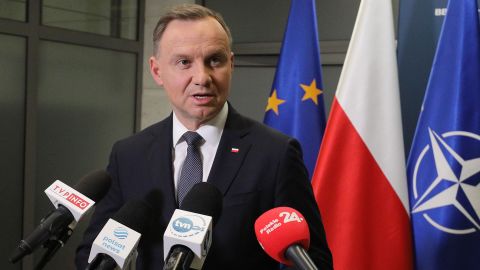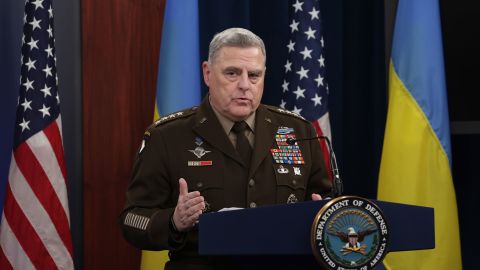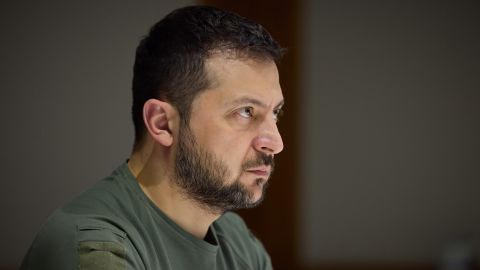Washington
CNN
—
President Joe Biden was asleep on the other side of the world when aides woke him up in the middle of the night there with urgent news: a missile had struck Poland and killed two people.
By 5:30 am local time in Bali, where the president was attending the G20 summit, Biden, still in a t-shirt and khakis, was on the phone with his Polish counterpart Andrzej Duda seeking clarity on where the missile had actually come from – a critical fact due to the potentially dire implications of a Russian missile strike on a NATO ally.
Secretary of State Antony Blinken, who was traveling with Biden, had also been roused with a knock on the door by his body man around 4 a.m. local time with news of the explosion, a US official said – news that most US officials only discovered from public reports and conversations with Polish officials.
Blinken and national security adviser Jake Sullivan spoke to their Polish counterparts and joined Biden for the call with Duda.
Polish officials first began hearing about a potential explosion in the eastern border village of Przewodów around 10 a.m. ET on Tuesday, or 11 pm Bali time, sources said, and information began trickling out publicly and briefed to allies around 1 p.m. ET, or 2 a.m. in Bali.
As the morning wore on there and more intelligence came in, it became clear to American officials examining satellite-based intelligence systems and speaking to their Polish counterparts that the missile, which landed on a Polish farm in the country’s far east, appeared to have been launched by Ukraine as part of its air defense systems.
After several anxious hours, Biden was the first to relieve some of the tension, telling reporters that initial information suggested the missile was not launched by Russia.
The relief among US officials was palpable. Contrary to their worst fears the preliminary intelligence suggested that Russia had not deliberately attacked Poland, one official said. But for Biden and his advisers, the episode still represented a situation they had long feared: an unintentional strike in NATO territory, for which the implications and consequences remained murky.
With the situation so fluid, Biden’s advisers urged calm and patience, including to Ukrainian officials.
Around an hour after the news broke of the incident, Volodymyr Zelensky said in his nightly address that “Russian missiles hit Poland,” calling it “a very significant escalation” that required a response.
Sullivan quickly called Zelensky’s office after those remarks, and urged officials to tread more carefully with how they were speaking about the incident, sources familiar with the call said. Biden and Zelensky did not speak on Tuesday night, despite requests by the Ukrainian leader to arrange a call, a source familiar with the matter said.
The US and Poland quickly agreed to work closely together on an investigation of the strike, and CIA Director Bill Burns met with Duda in Warsaw on Wednesday evening, a US official said. Just hours before, Burns had been hunkered down at the US embassy in Kyiv as Russian missiles struck the city.
But the incident has also created some cracks in the West’s alliance with Ukraine.
Biden and Duda have now both said publicly that the missile appeared to have originated with Ukraine’s air defense system—a claim Zelensky has continued to adamantly deny, which has frustrated Polish officials, sources said.

And although Biden spoke with Duda and NATO Secretary General Jens Stoltenberg in the aftermath of the strike, and held emergency talks with world leaders at the G20, the president had still not spoken directly with Zelensky by Wednesday afternoon, sources familiar with the matter told CNN.
Instead, Sullivan spoke to Zelensky’s chief of staff in the hours after the explosion, the sources said, and Blinken spoke with his Ukrainian counterpart Dmytro Kuleba.
Ukraine has also requested to join the investigatory team, made up of US and Polish officials, inspecting the site of the missile strike, Zelensky said on Wednesday. “We have to participate in the investigation,” he told reporters. But that request has not yet been granted.
Back in Washington on Tuesday, Secretary of Defense Lloyd Austin was in a meeting with the Deputy Defense Secretary Kathleen Hicks and Chairman of the Joint Chiefs of Staff Mark Milley when an aide interrupted with the news of the explosion, and all three officials called their Polish counterparts soon after.
A short time later, around 2 p.m., a press conference with Pentagon spokesman Brig. Gen. Pat Ryder was mere minutes away. But some officials in the Pentagon had only just heard about a missile hitting Poland from the media, and the Pentagon had nothing to corroborate a Russian missile launch that struck NATO territory.
Pentagon officials had to decide whether to go through with it, knowing they had virtually no information to provide on what immediately became the single most important item of the day.
In the end, one official told CNN, the press shop pushed ahead, reasoning that cancelling the press conference at the last minute would signal the exact sort of panic officials were eager to avoid.
As Ryder stood at the podium, he fielded repeated questions about the missile for which he did not yet have any answers.
Meanwhile, Milley was in his office in the outer ring of the Pentagon, instructing his staff to line up phone calls, officials said. First up was his Polish counterpart, quickly followed by his Ukrainian counterpart. Milley hopped off one call and onto another, speaking to other defense chiefs, as well as to Gen. Chris Cavoli, the commander of European Command, who was also working the phones.

Milley’s staff worked to get his Russian counterpart, Chief of the General Staff Valery Gerasimov, on the line. The two last spoke towards the end of October, one of the only times they’ve held discussions since Russia’s invasion began. But this time, there was no call, and the two never spoke Tuesday night.
That evening, Milley and Austin briefed Biden on what they had learned about the incident.
By Wednesday, multiple senior US officials were saying publicly that intelligence pointed to the explosion coming from a Ukrainian air defense missile that landed in Poland accidentally. The US had also shared the classified information with allies before Wednesday morning’s North Atlantic Council meeting at NATO headquarters, an official said.
“We have seen nothing that contradicts President Duda’s preliminary assessment that this explosion was most likely the result of a Ukrainian air defense missile that unfortunately landed in Poland,” National Security Council spokesperson Adrienne Watson said in a statement.
In early examinations of the site of the explosion, debris was found that appeared to be from a Soviet-era S-300 missile, sources familiar with the intelligence said. The initial assessment is that the Ukrainian air defense missile tried to intercept a Russian missile but missed and landed in Poland, multiple US and NATO officials said.
In a press conference on Wednesday, Duda said that “from the information that we and our allies have, it was an S-300 rocket made in the Soviet Union, an old rocket and there is no evidence that it was launched by the Russian side. It is highly probable that it was fired by Ukrainian anti-aircraft defense.”
The US has also determined that the Russian missile likely continued on its trajectory and either hit its intended target or landed in close proximity to it, one official said.

Zelensky on Wednesday afternoon insisted that the missile was not launched by Ukrainian forces. He told reporters in Kyiv “I have no doubt that it was not our missile,” citing reports he had received from the command of the Ukrainian armed forces and the Air Force.
Zelensky also expressed frustration that Ukrainian officials had not been permitted to join the joint Polish-US investigation of the site, and said he wanted to see “the number on the missile, because all missiles have numbers on them.”
“Do we have the right to be in the investigation team?” Zelensky said. “Of course.”
On Thursday, Zelensky confirmed that Ukrainian investigators will be permitted to access to the site of the strike, and acknowledged that Ukraine did fire an air defense missile. “I don’t know what happened. We don’t know for sure. The world does not know. But I am sure that it was a Russian missile, I am sure that we fired from air defense systems,” Zelensky said.
Only after the investigation would it be possible to draw conclusions about which missile fell on the territory of Poland, he added.
This story has been updated with comments Zelensky made on Thursday